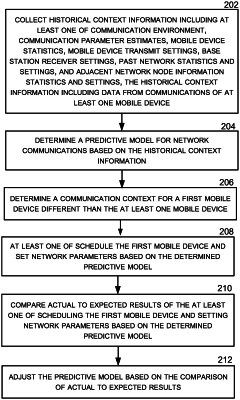| CPC H04W 16/22 (2013.01) [G06N 5/048 (2013.01); H04W 24/08 (2013.01)] | 20 Claims |

|
1. A method for optimizing mobile network communications using network learning, the method comprising:
collecting historical context data representing performance of a plurality of mobile devices operating in a plurality of cells of a mobile network,
wherein the historical context data is collected in the plurality of cells of the mobile network, and
wherein the historical context data includes at least one of communication environment, communication parameter estimates, mobile device statistics, mobile device transmit settings, base station receiver settings, past network statistics and settings, and adjacent network node information statistics and settings;
building a predictive multi-cell model to optimize scheduling of network traffic in one or more cells of the mobile network based on the historical context data for the plurality of cells;
determining a first predictive cell-level model for a first cell based at least in part on the predictive multi-cell model;
determining a second predictive cell-level model for a second cell based at least in part on the predictive multi-cell model;
scheduling network traffic for a mobile device in the first cell using the first predictive cell-level model for the first cell;
scheduling network traffic for a mobile device in the second cell using the second predictive cell-level model for the second cell;
adjusting the first predictive cell-level model to further optimize scheduling of network traffic for the first cell based at least in part on additional information from the first cell;
adjusting the second predictive cell-level model to further optimize scheduling of network traffic for the second cell based at least in part on additional information from the second cell.
|